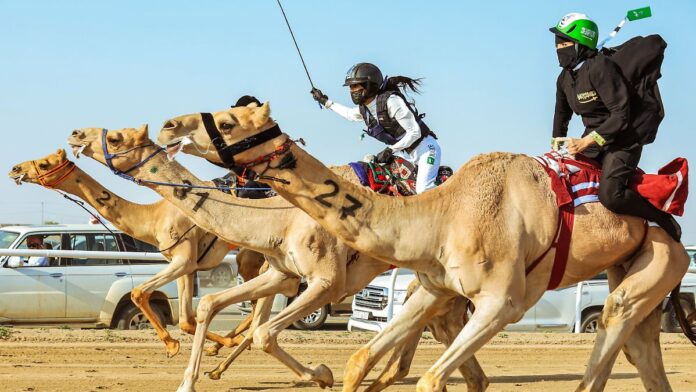Saudis are changing traditional sports
Centuries of waiting: women are finally allowed on camels
September 26, 2024, 6:46 p.m
The tradition of camel racing goes back centuries. With the opening up of society in Saudi Arabia, women are now also taking part. A German is driving change. The races on the humped animals are extremely lucrative.
There’s a bit of growling and grunting at the start, but then the gate pulls up and the camels gallop off. With their necks stretched, they let their long legs fly over the sandy track, making a wide curve towards their destination. “Jah! Jah! Jah! Jah!” shouts a camel owner from a car next to the race track, leans out of the window and bangs on the car door to encourage the animal and jockey. The prize money doesn’t win itself.
In Taif in the southwest of Saudi Arabia you can watch a Grand Prix of camel racing. There is more than 13 million euros in prize money in the pot for winners and well-placed players from 250 rounds. The camel festival in honor of Crown Prince Mohammed bin Salman, this year in its sixth edition, is on a par with the most awarded horse races in the world. 21,000 camels are in Taif this year.
Women are now “part of the program”
For centuries, camel riding on the Arabian Peninsula was primarily a male activity, but now women are entering the sport – with the help of a German woman from Baden-Württemberg. “Last year everything was an exception, now it’s really part of the program,” says Linda Krockenberger, who comes from near Schwäbisch Hall and who opened the first camel riding school for women in Dubai. “Confidence is growing that women can do it too and that the training wheels are being taken off,” says the 33-year-old.
“Dschah! Dschah! Dschah! Dschah!” a camel owner shouts from a car next to the race track.
(Photo: dpa)
The official premiere, a women’s camel race under the supervision of a federation, took place here in Taif last year. Krockenberger brought ten women to the start – this year there are already 25. The separate women’s races fit the modern look that Saudi Arabia has been trying to give itself for several years: women are allowed to drive cars, start businesses – or even compete in camel races. “It’s not accepted by everyone,” says an Iranian rider. “But some people are really supportive.” According to human rights activists, Saudi Arabia still performs poorly when it comes to women’s rights despite the reforms.
Top class camels compete
On the Arabian Peninsula, the one-humped people were and are a status symbol, once held for meat, milk, wool and leather skin and as a means of transport. Racing is said to have existed as a popular sport as early as the 7th century, and later also at weddings and religious festivals. The sport spread to East Africa, India and Australia. In the Arabian region, the top class competes thanks to special training and breeding programs, including artificial insemination and embryo transfers. Even their camels from Dubai are not good enough here, says Krockenberger.
What began with nomadic desert peoples is now being pushed to the best using modern means. Most of the time there are no jockeys sitting on the humps anymore, but rather small robots whose owners can trigger the whip strokes via radio. The lower weight of the robots allows young animals to run faster, which means they suffer fewer vertebral injuries. Owners and trainers rush along in off-road vehicles on the asphalt next to the race track, jostling and honking their SUVs, and sometimes there is a bang.
“Against every law of physics”
Concentrated looks as Krockenberger and her team sit up. Their feet – they ride in socks – are clamped back under the seat blanket and their knees are supported on the camel’s back. There are no saddles and stirrups like on horses. “You jump incredibly. It goes against every law of physics,” says a participant after the race. Although the run is only two kilometers long and only takes a few minutes, some people’s hands are still shaking half an hour later.
“It’s such an exhausting three minutes that you simply can’t underestimate it,” says Swaantje Jorina Niehus, who traveled from Zug, Switzerland, for the race. She started at Krockenberger’s school two years ago and now flies to Dubai for training about every three months. To a certain extent, you are at the mercy of the camel, says Niehus. The animals, which weigh up to 800 kilograms, usually continue to gallop or trot to their destination once the herd has started running. “You can stop at horse racing. That’s not possible here.” An Algerian from Krockenberger’s team took first place, and she was completely distraught when she took the photos on the winner’s step.
Krockenberger knows that it takes patience until big official races take place in the Emirates. Beyond the stands, beaters lead the herds of camels around. “If I don’t do it,” she said, “then who will?”

